Answer these simple questions and we will find you the BEST prices
Which type of solar quotes do you need?
It only takes 30 seconds
100% free with no obligation

Get Free quotes from insulation specialists near you

Save money by comparing quotes and choosing the most competitive offer

The service is 100% free and with no obligation
- GreenMatch
- Insulation
- Ceiling Insulation
Ceiling Insulation: Your Complete Guide (2025)

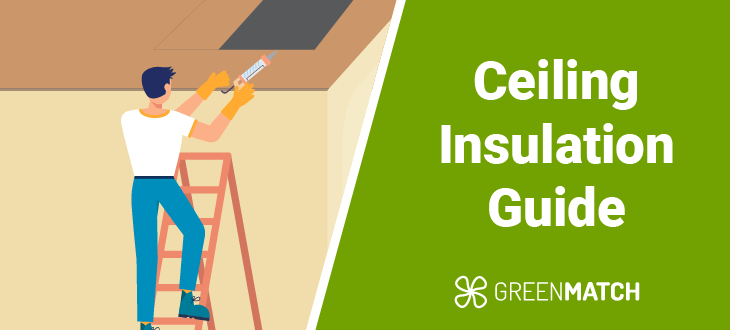
- The average cost to insulate your ceiling ranges from £25 to £35 per m2. However, this cost increases to between £70 to £100 per m2 for sloped or suspended ceilings.
- You can select thermal insulation to improve energy efficiency or acoustic insulation to reduce noise pollution inside and outside your home.
- Closed-cell spray foam is the best option for thermal efficiency.
- Mineral wool is the top choice for effective sound absorption due to its high density, which effectively absorbs sound waves.
Ceiling insulation is frequently overlooked when homeowners seek to enhance energy efficiency and comfort. However, effective ceiling insulation, whether in the basement, intermediate, or upper floors, is pivotal in reducing heat loss and maximising thermal efficiency, especially during colder months.
Insulating your ceiling can help reduce your energy bills. On average, better-insulated homes see a yearly reduction in energy bills of between £270 and £445. Additionally, insulation contributes to a more sustainable living environment, cutting carbon emissions by 0.6 tonnes per year.
Moreover, quality insulation is a robust barrier against sound transmission between floors. Specially designed acoustic insulation materials absorb and dampen noise, creating a quieter and more peaceful home. Whether your goal is to minimise heat loss or reduce noise pollution, investing in proper insulation provides substantial benefits, significantly enhancing your home's energy efficiency and comfort.
This comprehensive guide will explore the various ceiling insulation types available, their benefits, and how they can revolutionise your living space. By understanding the critical role that insulation for ceilings play within your home, you can enhance your home's efficiency and comfort while also contributing to a greener planet.
If you're considering insulating your ceilings, it's crucial to collaborate with reliable and skilled insulation professionals who will not only handle the installation but also offer expert guidance tailored to your specific needs and budget.
At GreenMatch, we specialise in connecting you with the top insulation specialists in your area. Simply fill out our 30-second form, and we'll supply you with four complimentary quotes from leading insulation contractors. No hidden fees, no commitments. Click below to find out more.
- Describe your needs
- Get free quotes
- Choose the best offer
It only takes 30 seconds



What is ceiling insulation?
Ceiling insulation involves adding insulation to either the attic floor (the ceiling of your top floor) or between floors in a multi-story home. This type of insulation allows you to choose specific ceilings in particular rooms based on your needs. Here are the ceiling types you can insulate:
- Conventional ceilings: The most common type, featuring a flat and smooth surface.
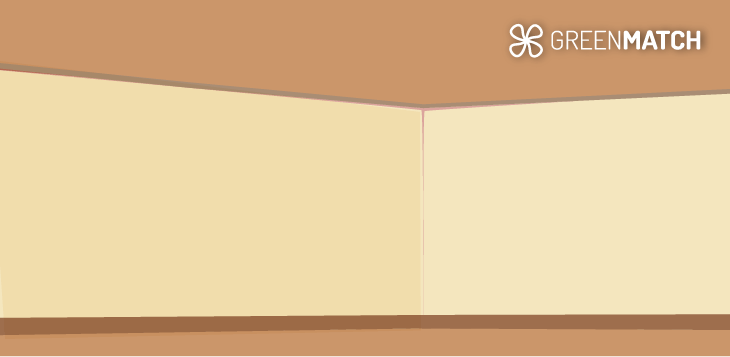
- Vaulted ceilings: These are angled towards the roof and often contain a self-supporting arch. Unlike conventional ceilings, they have an arched shape.
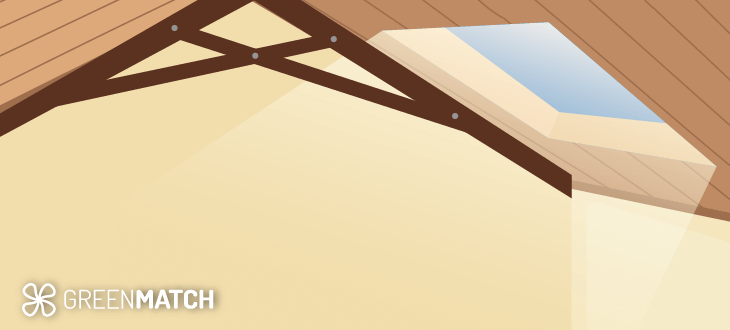
- Drop ceilings: Also known as false ceilings, drop ceilings are found in many commercial buildings, such as supermarkets or office spaces, and are hung below the structure's real ceiling.

Depending on your home's ceiling type, you can choose between spray foam, loose-fill, and blanket insulation. Each method offers advantages and suits specific types of ceilings better. The following sections will discuss these methods and the materials for ceiling insulation.
Poorly insulated ceilings are prone to thermal bridging, which are weak points that allow heat to escape easily. Since heat rises, it will naturally seek out these uninsulated areas, leading to up to 25% heat loss, according to GOV.UK. Properly insulated ceilings can prevent thermal bridging by making heat escape harder.
Insulating your ceilings enhances your home's energy efficiency, reduces utility bills, and improves overall comfort. Additionally, ceiling insulation helps with soundproofing, reducing noise between floors and creating a quieter living environment.
Acoustic vs thermal ceiling insulation
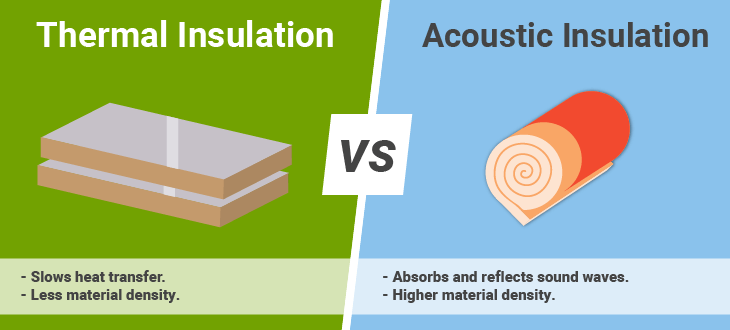
Acoustic and thermal insulation serves two primary purposes for ceilings: reducing noise and improving energy efficiency. Thermal insulation, widely used in the UK, keeps heat inside during winter, reflects it in summer, and reduces energy costs.
On the other hand, acoustic insulation is designed to minimise noise transmission, which is very useful in multi-floor homes or noisy areas, creating a quieter living environment. It's important to understand that while thermal insulation is not very effective at soundproofing, acoustic insulation generally has a lower R-value, meaning it is less effective at preventing heat loss.
One great advantage of ceiling insulation in a well-insulated home with good wall and roof insulation is that you can use acoustic insulation on intermediate floors to reduce noise without sacrificing thermal efficiency. However, if you need both thermal efficiency and soundproofing, some materials offer both benefits.
For example, Fibretex consists of dense rock wool insulation made from natural rock and recycled materials, bonded with thermosetting resin. This material effectively prevents heat loss and blocks sound waves, reducing noise within your home.
Below, we will provide more detailed information on thermal and acoustic insulation to help you understand the benefits for your home and ceilings.
Acoustic ceiling insulation
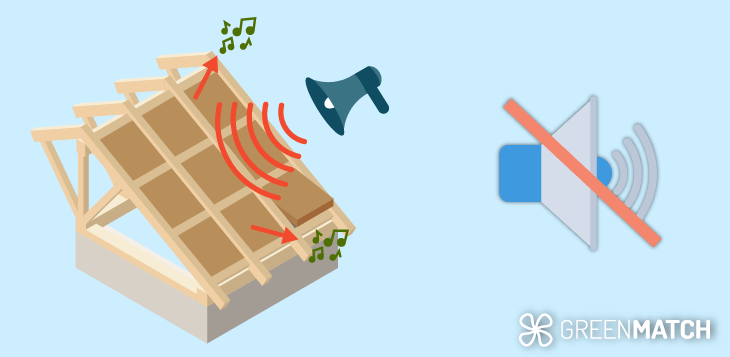
Acoustic ceiling insulation works by absorbing and blocking soundwaves. Sound travels through the air and reflects off hard, smooth surfaces, creating more noise, or absorbs into softer surfaces.
Acoustic insulation materials absorb sound waves rather than reflect them. This reduces noise pollution and enhances comfort within the home. This type of insulation improves productivity by creating a quieter environment and supports hearing health by lowering the risk of hearing damage. The absorption of sound is achieved through the fibrous nature of materials such as:
- Mineral wool
- Fibreglass
- Cotton wool
- Spray foam
While acoustic insulation materials can also be used for thermal insulation, they generally have lower R-values (typically 3 to 4 per inch) than specialised thermal insulation materials, which can have R-values up to 7 per inch. Although acoustic insulation can enhance thermal efficiency, it is less effective than dedicated thermal insulation.
Furthermore, acoustic insulation is denser due to its fibrous structure, making it heavier and more challenging to install. The increased density can lead to higher thermal conductivity, which may reduce the material's effectiveness in providing thermal insulation.
Thermal ceiling insulation
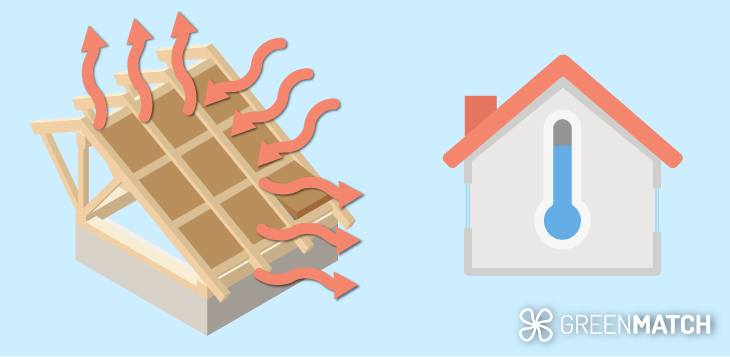
Thermal ceiling insulation reduces the rate at which heat moves between areas with different temperatures. Heat naturally rises and moves toward colder areas, so poorly insulated homes can lose heat to the attic, roof, and outside.
Thermal insulation creates a barrier that slows the heat flow, leading to increased energy efficiency, lower energy bills, and a reduced carbon footprint. For effective thermal insulation, materials must have low heat conductivity and minimal airflow that could carry heat away.
The best thermal insulation materials have a high R-value and include:
- Polyisocyanurate (PIR) boards
- Polystyrene (EPS) boards
- Polyurethane (XPS) boards
- Spray foam insulation
Mineral wool, cellulose, sheep wool, spray foam, and fibreglass can also provide thermal insulation, but PIR, EPS, XPS boards, and spray foam, with an R-value of 4 to 7 per inch, are more effective.
Ceiling insulation materials
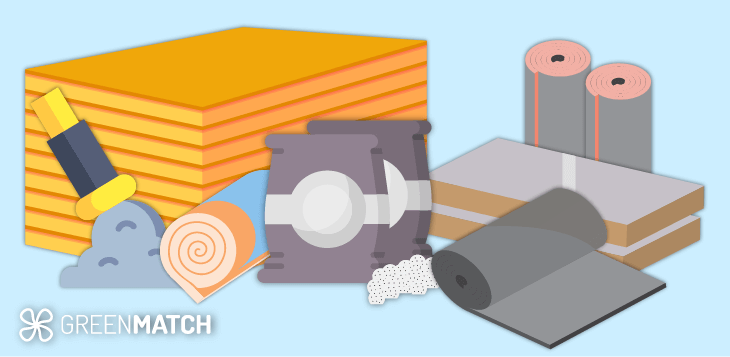
Ceiling insulation materials are essential for enhancing energy efficiency, comfort, and safety in homes. Various materials are available, each offering unique benefits and properties suitable for different needs and environments. below are a list of the materials available for insulating your ceiling:
- Fibreglass
- Cellulose
- Spray foam (Open and closed cell)
- Rigid foam boards
- Mineral wool
- Sheep wool
Before selecting insulation for your ceiling, it is essential to consider several factors to ensure optimal performance, efficiency, and suitability for specific needs. Here are the key considerations:
| Factor | Description |
|---|---|
| High R-value | For maximum thermal efficiency, select a material with a high R-value if you are looking for thermal insulation. |
| Acoustic properties | If noise reduction is your priority, then it is essential to look at materials that have good sound-absorbing qualities. |
| Sustainability | Ensure that the material you choose is suitable for your ceiling type |
| Moisture resistance | Select materials that resist moisture and prevent mould growth, especially in areas prone to humidity. |
| Fire resistance | Check the insulation material's fire rating, especially for spaces requiring higher fire safety standards. |
| Ease of installation | Some materials are easier to install than others, affecting labour costs and installation time. |
| Cost | Consider the budget for the project, including material costs and installation expenses. |
Below, we go into further detail, highlighting the advantages and drawbacks of each insulation material so that you can make an informed decision regarding your ceiling insulation.
Fibreglass
Fibreglass is one of the most popular and widely used insulation materials. It comprises fine glass fibres in batts, rolls, or loose-fill forms. Due to its fibrous nature, it is an excellent acoustic insulator.
It is known for being affordable at £10 per m2 and easy to install.
Fibreglass provides good thermal insulation with moderate R-values of 3 to 4 per inch. It is also non-combustible, adding a layer of fire resistance.
However, fibreglass is susceptible to moisture, resulting in mould growth. Additionally, wet fibreglass will decrease its ability to block heat transfer, decreasing its R-value. Not wearing protective gear can lead to skin irritation and respiratory issues, posing a health risk.
Although made from sustainable materials, fibreglass production generates significant pollutants. It has a long lifespan of between 30 and 40 years, however it is non-biodegradable. These factors mean that this ceiling insulation material is not the best choice for eco-conscious people.
- Cost-effective
- Easy to install
- Fire-resistant
- Sound absorption
- Health risks
- Moisture sensitivity
- Mould and mildew can grow
- Not eco-friendly
Cellulose
Cellulose insulation is made from recycled paper products, making it an eco-friendly option. It is treated with fire-retardant chemicals for safety. Installers typically blow cellulose into place, making it ideal for filling gaps and hard-to-reach areas. It offers moderate thermal performance of between 3.1 and 3.8 per inch and has soundproofing qualities.
At around £11 per m2, it is one of the best cost-effective sustainable ceiling insulation materials. However, cellulose insulation is not moisture-resistant, which can cause it to sag and reduce its R-value. The material creates dust during installation, so you need protective gear to prevent lung irritation.
- Eco-friendly
- Cost-effective
- Fire-resistant
- Easy installation
- Moisture sensitivity
- Susceptible to sagging and settling
- Dust generated during installation
Spray foam (Open and closed cell)
Spray foam insulation comes in two main types: closed-cell and open-cell. Closed-cell spray foam has a high R-value, ranging from 6 to 7 per inch. It is an effective air and moisture barrier, making it suitable for high-moisture areas. However, it is more expensive than other insulation materials, costing around £70 per m2.
On the other hand, open-cell spray foam is less dense, offers good sound absorption, and has a lower R-value, ranging from 3.6 to 3.9 per inch. It typically costs around £50 per m², making it cheaper than closed-cell foam, but still an expensive ceiling insulation option. The open-cell foam expands more than the closed-cell options, providing a more airtight seal.
Spray foam is resistant to mould and mildew, even when damp, which is excellent for preserving the structure and health of your ceiling. It's also durable, with a lifespan of up to 100 years, but it's not biodegradable, adding to your carbon footprint.
Due to their application process, both types of spray foam require professional installation. Spray foam can release volatile organic compounds (VOCs) and isocyanates, which can have adverse health effects if not handled correctly. After application, your home must be vacated for 24 hours while the foam cures. Additionally, it's essential to know that spray foam is flammable, making it prone to spreading fire and releasing toxic chemicals.
- Closed cell has high R-value
- Airtight
- Longevity
- Moisture resistant
- Open-cell offers good sound absorption
- Flammable
- High-cost
- Health risks
- DIY not possible
- Not eco-friendly
Rigid foam boards
Rigid foam board insulation comprises materials like polystyrene (EPS and XPS) and polyisocyanurate (PIR). These sturdy panels offer high R-values per inch and excellent moisture resistance. They are lightweight and can be used in various applications, including ceiling insulation. Foam boards are easy to cut and install, making them versatile.
EPS boards have the lowest R-value, ranging between 4 to 4.5 per inch, but they are the most cost-effective option of the three, averaging around £10 per m2. However, EPS is a flammable material that can release toxic chemicals at high temperatures.
PIR boards have the highest R-value, ranging between 5.6 to 7.0 per inch, and cost around £12.50 per m2. Additionally, they are fire-resistant but susceptible to moisture absorption, which can reduce their R-value when damp.
Finally, XPS boards have an R-value between 5 to 6 per inch and cost around £21.50 per inch. They are considered one of the most durable rigid foam boards available. Although moisture-resistant, they are flammable and can release toxic chemicals when exposed to high temperatures.
Additionally, rigid foam boards are not the most eco-friendly choice for ceiling insulation due to their reliance on petroleum-based products and the environmental impact of their manufacturing process. The production of polystyrene and polyisocyanurate involves significant energy use and emissions of greenhouse gases and other pollutants.
- High R-value
- XPS and EPS are moisture resistant
- PIR boards are fire-resistant
- Easy to install
- XPS boards are costly
- XPS and EPS boards are flammable
- PIR boards are not moisture resistant
- Not eco-friendly
Mineral wool
Mineral wool, which includes rock wool and slag wool, is made from natural stone or industrial by-products. It provides adequate thermal insulation and has an average R-value between 3.7 and 4.3 per inch. It is also a great acoustic insulator and is fire-resistant.
Mineral wool is available in batts or loose fill. It is known for its durability, lasting up to 50 years, and its resistance to moisture and mould. However, mineral wool is heavier and more challenging to install than other materials. During installation, protective gear is necessary to prevent skin and respiratory irritation.
Mineral wool is also more expensive than other materials, with glass wool priced at around £15.25 and rock wool priced at £18.20 per m2. While mineral wool can be produced from recycled materials, its production is not environmentally friendly due to heavy machinery, which produces carbon dioxide during manufacturing.
- Fire-resistant
- Water resistant
- Sound absorption
- Durable
- High-cost
- Heavy weight
- Difficult to install
- Not eco-friendly
Sheep wool
Sheep's wool is a natural and renewable material with good thermal insulation and an R-value between 3.5 and 3.8 per inch. Its density makes it an excellent acoustic insulation material that is naturally fire-resistant.
Sheep's wool can absorb and release moisture without losing its insulating properties, making it suitable for various climates. This prevents condensation and the growth of mould and mildew. Additionally, it is biodegradable and environmentally friendly.
It is a flexible material that is easy to install and does not require any protective gear, as it will not damage the skin or respiratory system. While not difficult to install, ensuring a proper fit and avoiding compression is essential for maintaining its insulating properties.
On average, sheep's wool costs around £19.75 per m2, making it one of the most expensive eco-friendly insulation materials. Additionally, if not properly treated, wool can be attractive to pests such as moths. However, most commercial wool insulation is treated to deter pests.
- Moisture regulation
- Eco-friendly
- Fire-resistant
- Easy to install
- Effective sound absorption
- Expensive
- Lower R-valued compared to other materials
- Susceptible to pests
- Proper insulation required to ensure insulation properties
Best ceiling insulation

When choosing the best insulation for your ceiling, it's essential to consider factors such as cost, sustainability, thermal efficiency, and acoustic efficiency. Remember that there is no one-size-fits-all solution, so you may need to make some compromises. Prioritise the factors that are most important to you.
However, there are two ceiling insulation materials that stands out as the best for thermal and acoustic insulation:
- Mineral wool: Is excellent in its effectiveness for fire-resistant and acoustic efficiency. Its dense structure effectively absorbs sound, making it ideal for noise reduction. It is water-resistant which prevents the growth of mould.
- Spray foam (closed-cell): Is a superior thermal insulator and is an airtight solution for ceilings. Additionally it is moisture resistant, preventing the growth of mould and is highly durable. This is considered the best option for ceiling insulation in the UK.
These two insulating materials are excellent for acoustic and thermal insulation. Some other materials are more cost-effective or sustainable. Below, we have provided a table of the best ceiling insulation for particular preferences:
| Preference | Material |
|---|---|
| Budget | Fibreglass |
| Sustainability | Sheep wool |
| Thermal efficiency | Spray foam |
| Acoustic efficiency | Mineral wool |
It's crucial to partner with a skilled insulation specialist who can help you select the best material for your preferences, home, and ceiling. GreenMatch connects you with top insulation specialists in your area. With just a 30-second form, we can provide four free, customised quotes from top contractors. There are no hidden costs or obligations. Click below to discover more.
- Describe your needs
- Get free quotes
- Choose the best offer
It only takes 30 seconds



Which ceilings can be insulated?
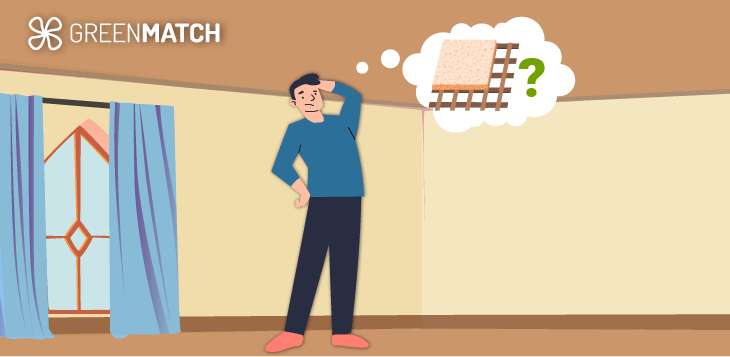
You can apply insulation to various ceiling types, offering benefits for energy efficiency, soundproofing, and comfort. Below are the types of ceilings that can be insulated:
- Conventional ceilings, or flat or standard ceilings, are the most common type of ceiling in UK homes. They typically have a flat, horizontal surface that runs across the entire room at a consistent height, making it accessible to install ceiling insulation. Conventional ceilings are often constructed with a framework of joists and beams, which provide structural support and create cavities where insulation can be installed.
- Drop or suspended ceilings are secondary ceilings that hang below the main structural ceiling. They are commonly used in commercial buildings, offices, and basements but can also be found in homes.
- Vaulted ceilings are an architectural design in which the ceiling rises significantly higher than a standard flat ceiling. Unlike flat ceilings, vaulted ceilings have slopes that rise to a peak, often following the roofline. The slope can be steep or gradual, depending on the design. While this design may be more difficult to insulate, insulating the ceiling with the correct materials, such as spray foam, is possible.
It is important to know what type of ceiling can be insulated. Deciding whether to insulate all ceilings or focus on specific rooms depends on various factors, including the building’s design, usage, and climate. By insulating all ceilings in your home, you can provide uniform comfort, enhance thermal efficiency, and reduce noise transfer from different parts of your home.
However, if your home already has some insulation or you are budget-conscious, you can choose to focus on different ceilings within your home. This can reduce overall ceiling insulation costs and focus on specific needs within your home. Below, we will discuss which ceilings within your home are the best to insulate.
Ceiling insulation between floors

Insulating the ceilings between floors in multi-story buildings or homes can improve soundproofing and energy efficiency. You can reduce noise transmission between floors by choosing acoustic insulation, creating a quieter living environment. Alternatively, thermal insulation can help maintain consistent temperatures across different floors, improving energy efficiency.
Basement ceiling insulation
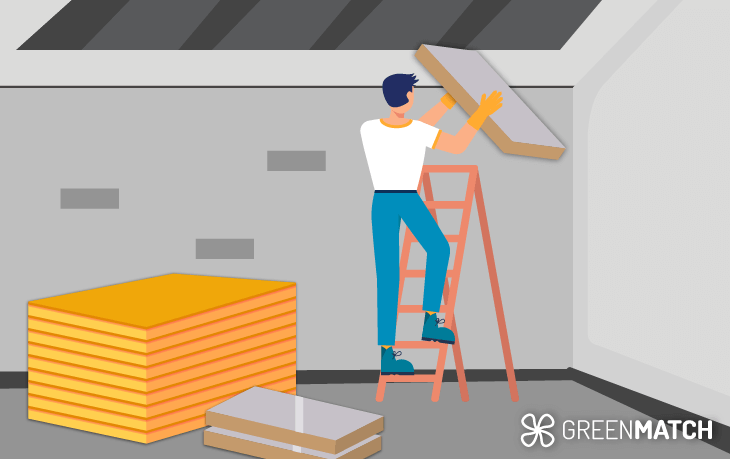
Basements cool down much faster than any other area in your home. As a result, it is more exposed to damp issues. To avoid these issues, adding basement ceiling insulation is an effective way to regulate temperature and prevent condensation. It is essential to note that water-resistant insulation materials such as XPS or EPS rigid foam boards should be used.
Cold roof insulation
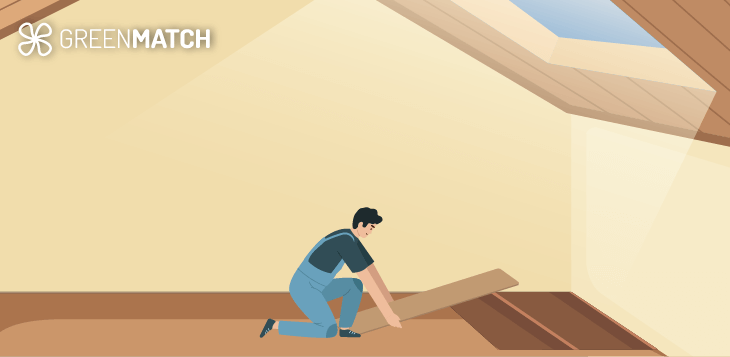
This method involves placing insulation over and between the joists at ceiling level on the top floor, where the attic is located. By insulating the uppermost ceiling inside of your home, you create a thermal barrier that prevents heat from escaping the living space into the attic. This is a cost-effective solution for roof insulation; however, it is unsuitable for loft spaces used as living areas.
How much does ceiling insulation cost?
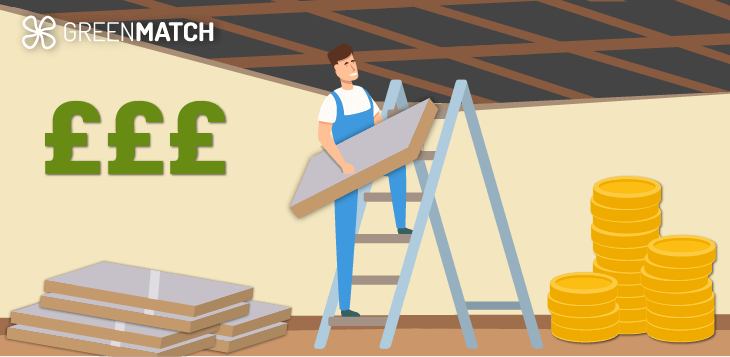
The cost of ceiling insulation can vary based on factors such as the type of material, the size of the area, and the complexity of the installation. The cost of a standard conventional ceiling can range from £25 to £35 per square metre. However, the cost can be between £70 to £100 per square metre for more complex ceilings like suspended or vaulted ceiling insulation.
When calculating the costs of ceiling insulation, it's essential to consider both material and labour costs. On average, insulation specialists charge around £250 per person per day. If you are insulating multiple ceilings or the structure is more complex, it will take more time to install, increasing the labour costs.
Below, we have provided the average materials costs per square metre to help you better understand the costs of ceiling insulation.
| Material | Average cost per m2 |
|---|---|
| Fibreglass | £10 |
| Polystyrene (EPS) Board | £10 |
| Cellulose | £11 |
| Polyisocyanurate (PIR) board | £12.50 |
| Mineral wool (glass) | £15.25 |
| Mineral wool (rock) | £18.20 |
| Sheeps wool | £19.75 |
| Polyurethane (XPS) board | £21.50 |
| Spray foam open cell | £55 |
| Spray foam closed cell | £70 |
Pros and cons of insulating a ceiling
Insulating your ceiling is a worthwhile investment due to its numerous benefits. However, it is equally important to consider the drawbacks to make an informed decision. By fully understanding the advantages and potential challenges of ceiling insulation, you can choose the best option for your needs and budget.
Below we go into detail on the advantages and disadvantages of insulation for ceilings.
Pros of ceiling insulation
- Improved energy efficiency: Properly insulating your ceiling helps maintain a consistent indoor temperature, reducing the need for excessive heating in the winter and cooling in the summer. This leads to lower energy consumption and significant savings on energy bills.
- Enhanced comfort: Insulation helps maintain a consistent, comfortable temperature throughout the year by keeping your home warm in the winter and cool in the summer. It also minimises drafts by sealing gaps and preventing air leaks.
- Soundproofing: Acoustic insulation materials such as mineral wool and dense fiberglass excel at absorbing sound, reducing noise transmission between rooms and floors. This is especially beneficial in multi-story homes and buildings.
- Moisture control: Proper insulation helps regulate moisture levels by preventing condensation, which can lead to mould and mildew growth. This is especially crucial in high-humidity areas. Furthermore, reduced mould and mildew growth contributes to better indoor air quality, minimising respiratory and other health problems.
- Increased property value: Homes with good insulation are often more attractive to buyers due to their energy efficiency and comfort benefits, potentially increasing the property's resale value. According to GOV.UK, improving your EPC (Energy Performance Certificate) rating could raise your home's value by up to 14%.
- Reduced Carbon Footprint: Lower energy consumption results in reduced greenhouse gas emissions, contributing to a smaller carbon footprint and a more environmentally friendly home. On average you can reduce your carbon emission by 0.6 tonnes annually.
Cons of ceiling insulation
Ceiling insulation offers benefits, but consider material type, installation complexity, and associated costs, which can sometimes pose disadvantages.
- Cost: The initial cost of installing ceiling insulation can be significant, especially for high-end materials like spray foam or rigid foam boards. If your ceiling has a more complex structure, this can lead to increased prices.
- Installation challenges: Installing insulation in certain ceilings, such as vaulted or sloped ceilings, can be complicated and time-consuming. It often requires specialised equipment and expertise. Additionally, installing insulation in the ceiling may require additional access to the attic or removing ceiling panels, which can be inconvenient.
- DIY risks: Although some types of insulation are suitable for DIY installation, improper handling or installation can lead to safety hazards, ineffective insulation, or damage to the building structure. Poorly installed insulation can result in gaps or compression, reducing the insulation's effectiveness and leading to air leaks that compromise thermal and acoustic performance.
- Moisture issues: Some insulation materials, such as cellulose or PIR boards, can absorb moisture if there are leaks or high humidity levels, reducing their effectiveness and potentially causing water damage and mould.
- Environmental issues: Certain insulation materials, like certain foams and fibreglass, are produced from non-renewable resources and have more significant environmental impacts because of their manufacturing processes. Additionally, disposing of insulation materials at the end of their life cycle can be difficult, leading to increased landfill waste and environmental pollution.
Get multiple quotes on ceiling insulation
Securing the best value and quality for your ceiling insulation is crucial. Comparing quotes from different contractors allows you to decide based on costs and services. This process identifies competitive pricing, ensuring you don’t overpay and helps you choose the best option tailored to your needs. Reviewing several quotes can reveal potential red flags, ensuring you select a reputable contractor for a high-quality and satisfactory outcome.
However, this process can be time-consuming, and comparing quotes can be challenging. Despite this effort, the payoff might be minimal if the quotes are similar in cost or if the cheapest option compromises quality.
Luckily, GreenMatch can offer you a quick and easy solution to compare multiple quotes. By filling out our swift 30-second form, we will provide four free quotes from the best ceiling insulation specialists tailored to your needs and budgets. Click below to find out more.
- Describe your needs
- Get free quotes
- Choose the best offer
It only takes 30 seconds



FAQ
The best type of insulation for ceilings depends on your specific needs. Spray foam insulation is excellent for maximum thermal efficiency and air sealing, while mineral wool offers excellent acoustic efficiency. Additionally, if you are budget-conscious, then fibreglass is the best option. At the same time, sheep wool is the most sustainable choice available.
The best way to insulate a ceiling is to use spray foam insulation, as it provides excellent thermal performance, air sealing, and moisture resistance.
Yes, you can insulate your ceiling from the inside by installing insulation materials between the ceiling joists.
Yes, insulating internal ceilings is worth it as it enhances energy efficiency by reducing heat transfer between floors, and improves soundproofing, creating quieter living spaces. Additionally, it can contribute to overall comfort and potentially lower energy bills.
The average cost of insulating a flat ceiling is between £25 and £35 per m2. However, for vaulted or sloped ceilings, the cost will increase to between £70 and £100 per m2. The total cost depends on the complexity of your ceilings, whether you choose to insulate all of them, and the materials you choose.

Caoimhe is an experienced content writer and researcher who is passionate about providing accessible information to every reader. With a background in English literature and Sociology, she combines the two disciplines to create cohesive, well-thought-out, and well-informed pieces.
We strive to connect our customers with the right product and supplier. Would you like to be part of GreenMatch?





